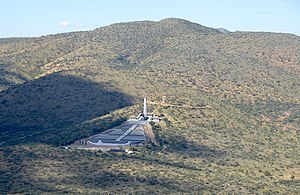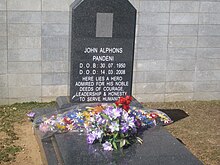Heroes' Acre (Namibia)

Heroes' Acre is an official war memorial of the Republic of Namibia. Built into the uninhabited hills 10 kilometres (6 mi) south of the city centre of Windhoek, Heroes' Acre opened on 26 August 2002. It was created to "foster a spirit of patriotism and nationalism, and to pass [this] to the future generations of Namibia".[1]
The memorial was designed and built by Mansudae Overseas Projects, a North Korean firm.[2] It is one of four major public works Mansudae constructed in Namibia, the other three being Okahandja Military Museum, a new State House and the Independence Memorial Museum.[2]
In February 2024, Namibia laid its President Hage Gottfried Geingob (1941-2024) to rest in one of the mausoleum located at the monument. Geingob who was at the time in his first term of presidency, played a pivotal role in the construction of the mausoleums that are reserved for Namibian President and was the first to be laid to rest in them.
Location and description
[edit]The Heroes' Acre monument is situated south of Windhoek on the B1 national road to Rehoboth. It is built as a symmetric polygon with a marble obelisk and a bronze statue of the Unknown Soldier at its centre. The site contains parade grounds and a grandstand for 5000 people. The burial site consists of 174 tombs, not all of which are currently[update] occupied.[3]
Honored heroes
[edit]At inauguration nine national heroes and heroines were identified. For each of them a tombstone with name and picture has been erected, although they are not buried here. The nine national heroes are:[4]
- Kahimemua Nguvauva (1850–1896), Chief of the Ovambanderu, was wounded May 1896 in the Battle of Sturmfeld and after his surrender executed by the Germans[5]
- Nehale Lya Mpingana (died 1908), King of Ondonga, defeated the settlers of the Dorsland Trek in 1886, and German colonial forces at Fort Namutoni in 1904[4]
- Samuel Maharero (1856–1923), Paramount Chief of the Herero people, led the uprisings against German colonialism that resulted in the Herero and Namaqua War of 1904–1907[4]
- Hendrik Witbooi (1830–1905), chief of the ǀKhowesin and fighter against the colonial oppression of the German Empire in German South West Africa[6]
- Jacob Morenga (1875–1907), used the fortress of ǁKhauxaǃnas to wage a guerrilla war against the Schutztruppe of Imperial Germany[7]
- Mandume Ya Ndemufayo (1894–1917), last king of the Kwanyama, led his people into battles with South African colonial forces[8]
- Iipumbu Ya Tshilongo (1875–1959), King of the Uukwambi and strong nationalist, resisted European cultural influence exercised via the establishment of mission stations and administrative outposts[4]
- Anna Mungunda (1910s–1959), protester against the forced eviction from Windhoek's Old Location in 1959. Set the car of a high-ranking administrator alight and was shot dead in response.[9]
- Hosea Kutako (1870–1970), Paramount Chief of the Herero and petitioner to the United Nations for an independent Namibia[10]
- Hage Gottfried Geingob(3 August 1941 – 4 February 2024) served as the third President of Namibia from 2015-2024
Others
[edit]
In later years, several additional people have been declared national heroes, and buried here. These are:
- Dimo Hamaambo (1932–2002), served as the second commander of the People's Liberation Army of Namibia[11]
- Maxton Joseph Mutongulume (1932–2004), founding member of the Ovamboland People's Congress and long-term SWAPO functionary and Central Committee member[12]
- Markus Kooper (1918–2005), petitioner to the United Nations[13]
- Mose Penaani Tjitendero (1943–2006), first speaker of National Assembly[14]
- Richard Kapelwa Kabajani (1943–2007), former cabinet minister and ambassador to Cuba[15]
- John Pandeni (1950–2008), prisoner of Robben Island and later Namibian Minister[16]
- Peter Tsheehama (1941–2010), People's Liberation Army of Namibia commander and Chief of Namibian Intelligence[17]
- John ya Otto Nankudhu (1933–2011), People's Liberation Army of Namibia commander and Robben Island inmate[18]
- Frederick Matongo (1946 or 1947–2013) Lieutenant Colonel of the Namibian Defence Force, early participant of the Namibian War of Independence against apartheid South Africa[19]
- Andrew Intamba (1947–2014), first director of the Namibia Central Intelligence Service, and Namibian ambassador to Egypt[20]
- Mzee Kaukungwa (1919–2014), veteran of the People's Liberation Army of Namibia and founding member of SWAPO.
- Gerson Veii (1939–2015), founding member of the South West Africa National Union (SWANU). Veii is the first opposition party member to be accorded a hero's burial[21]
- Hidipo Hamutenya (1939–2016), former cabinet minister, long-time leading member of SWAPO, founder of RDP.
- Andimba Toivo ya Toivo (1924–2017), anti-apartheid activist, politician and political prisoner. Founding member of SWAPO.
- Theo-Ben Gurirab (1938–2018), former Prime Minister, former Speaker of the National Assembly, veteran diplomat of SWAPO.
There are further National Heroes of Namibia without any connection to Heroe's Acre, namely:[22]
- Niko Bessinger
- David Moses Meroro
- John Mutwa[23]
- Ida Jimmy (1945–2024)[24]
Seven veterans of the Namibian liberation struggle were reburied on Heroes' Acre in 2014:[25][26]
- Peter Nanyemba
- Walde Homateni Timoteus Kaluenya
- Isak "Pondo" Shikongo
- Natalia Ndahambelela Shikangala Mavulu
- Augustus "McNamara" Nghaamwa
- Putuse Appolus
- Lineekela Kalenga
On 26 August 2015, Namibia's Heroes' Day, three more veterans were reburied on Heroes' Acre:[27]
Construction controversy
[edit]Mansudae Overseas Projects, a company from North Korea was given a N$60 million contract from Namibia to build the 732-acre (2.96 km2) monument. The contract was awarded without any competitive tendering process, and eventually the construction cost doubled.[3] The non-transparent contracting of foreign manual labour has been criticised by corruption watchdog insight Namibia.[28]
The memorial has been described as "monstrous" and its erection was speculated to "reveal a lack of African self-confidence". The statue of the Unknown Soldier resembles the physical features of Sam Nujoma,[3] Namibia's founding president and ultimately the initiator of its erection.[1]
In May 2005, a report in The Namibian noted that Heroes' Acre was "already showing signs of decay". In particular, a bronze statue of a soldier had suffered damage, as had the plinth on which it stood. Some of the gold-coloured letters forming an inscription on the plinth were broken or missing, and the letters were "made of a cement-like substance, which had been painted gold and then glued to the plinth".[29]
See also
[edit]References
[edit]- ^ a b Windhoek City Council: Archived 2008-04-12 at the Wayback Machine What to see, National Monuments in Windhoek
- ^ a b Hall, Nick (December 9, 2022). "Empty lots and baboon feces: North Korea's monuments in Namibia — in photos". NK News. Retrieved 8 January 2023.
- ^ a b c "Heroes' Acre Monument Namibia". Namibia-travel.net. Archived from the original on 12 June 2010. Retrieved 8 December 2010.
- ^ a b c d Nujoma, Sam (26 August 2002). "Heroes' Acre Namibia Opening Ceremony – inaugural speech". via namibia-1on1.com.
- ^ Mashuna, Timotheus (30 March 2012). "Chief Kahimemua Nguvauva: The Prophetic anti-Imperialist Chief of the Ovambaderu (1850–1896)". New Era. Archived from the original on 26 February 2015. Retrieved 8 August 2012.
- ^ Dierks, Klaus. "Biographies of Namibian Personalities, W". klausdierks.com. Retrieved 19 November 2022.
- ^ Dierks, Klaus. "Chapter 2: The Rediscovery of ǁKhauxaǃnas". ǁKhauxaǃnas. Retrieved 8 August 2012.
- ^ Order out of Chaos: Mandume Ya Ndemufayo and Oral History by Patrica Hayes in the Journal of Southern African Studies, 19.1, March 1993]
- ^ Angula, Nahas (10 December 2010). "Old location massacre: the spark that ignited the struggle for national independence". Speeches of the Prime Minister. Government of Namibia. Archived from the original on 29 November 2012.
- ^ Dierks, Klaus. "Biographies of Namibian Personalities, K". klausdierks.com. Retrieved 9 August 2012.
- ^ Dierks, Klaus. "Biographies of Namibian Personalities, H". klausdierks.com. Retrieved 26 February 2015.
- ^ Dierks, Klaus. "Biographies of Namibian Personalities, M". klausdierks.com. Retrieved 29 December 2014.
- ^ Markus Kooper: Death of a Hero New Era via allafrica.com, 19 December 2005
- ^ "The Decade of the 1970s". The Center for International Education. Archived from the original on 2 July 2012. Retrieved 19 July 2012.
- ^ Christof Maletzky: Richard Kabajani passes away The Namibian, 21 May 2007
- ^ Ekongo, John (20 March 2008). "Namibia: Pandeni Was a Born Leader – Iilonga". New Era. via allafrica.com.
- ^ Sasman, Catherine (29 October 2010). "Peter Tsheehama: The fighter (1941 to 2010)". New Era. Archived from the original on March 16, 2012.
- ^ "Nankudhu to be buried at Heroes' Acre". New Era. 29 June 2011. Archived from the original on 21 February 2013.
- ^ Haufiku, Mathias (9 November 2013). "Matongo was 'dedicated, well disciplined and fearless'". New Era.
- ^ Haufiku, Mathias (22 April 2014). "National hero Intamba to rest". New Era.
- ^ Kahiurika, Ndanki (26 February 2015). "Veii laid to rest". The Namibian. p. 5.[permanent dead link]
- ^ "NamLex Index to the Laws of Namibia" (PDF). Legal Assistance Centre. 2010. p. 122. Archived from the original (PDF) on 29 March 2017. Retrieved 4 February 2017.
- ^ "President Geingob confers honour of national hero to former NDF chief John Mutwa". NBC. 18 June 2021. Archived from the original on 18 June 2021. Retrieved 2 July 2021.
- ^ Petersen, Shelleygan (11 April 2024). "Hero's funeral for Jimmy !Ha-Eiros". The Namibian.
- ^ Remains of heroes to be repatriated
- ^ Remains of gallant fighters laid to rest at the Shrine of the Heroes' Acres. SWAPO party, retrieved 23 September 2017
- ^ "Families say reburials brings closure". 27 August 2015.
- ^ "The hidden world of public contracting" (PDF). insight Namibia. March 2008. Archived from the original (pdf) on 2011-07-22. Retrieved 2010-12-08.
- ^ Menges, Werner (6 May 2005). "Heroes' monument losing battle". The Namibian. Archived from the original on 24 July 2014. Retrieved 23 April 2014.
